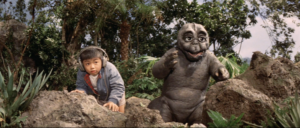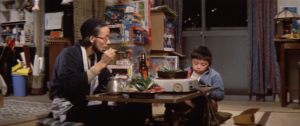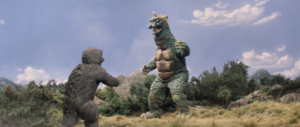Over the last decade or so, 1969’s All Monsters Attack has received a much-appreciated critical reappraisal. Often considered one of the worst entries in the Godzilla franchise, All Monsters Attack has polarised opinion, but is now regarded fondly by many fans and critics alike. This review will be another for the positive camp. All Monsters Attack (or, as it was incomprehensibly titled in America, Godzilla’s Revenge) is a wholesome film that manages to be both fun and melancholic.
Set in a world in which Godzilla films are just that, All Monsters Attack follows Ichiro (Tomonori Yazaki), a young boy obsessed with monsters. Both of Ichiro’s parents work long hours, often absent for several nights at a time. While Ichiro finds companionship in an old toymaker from his block of flats, he is a lonely kid who’s bullied by his peers. As an escape, Ichiro often dreams of Monster Island; and of palling around with Godzilla’s son, Minya (who can shrink to human-size to speak with Ichiro). On Monster Island, Minya has his own bully, a toad-like monster called Gabara. A parallel struggle against Ichiro and Minya’s bullies is therefore realised. Back in the real world, a second plot thread involving two bank robbers begins to take centre-stage. Ichiro accidentally finds one of the robber’s driver’s license and, after they kidnap him, Ichiro must gather the strength of his dreams to overcome the fiends.

Immediately, the setting makes things interesting; Godzilla is just a fictional character from a popular film series here. Therefore, Ichiro’s obsession with Godzilla makes him instantly recognisable as a surrogate for fans in the audience. Moreover, in scenes wherein Minya and Ichiro learn from one another, the film asserts how monsters – as personal talismans – are tools of emotional comfort and learning. Indeed, at the film’s end, toymaker Shinpei (Hideyo Amamoto in a charming performance) notes how, in the same way that adults turn to gods, children can turn to monsters. Therefore, All Monsters Attack manages a meta-textual comment on audience response to these films; how they have a tangible, emotional impact on their devotees; and how they can offer escape from an otherwise-unforgiving world.
In presenting Godzilla as purely fictional, the film elevates itself to a level of realism one might not presume of the picture. Setting this in the real world means that all of the thematic weight one usually finds in a Sekizawa-written/Ishiro Honda-directed movie is doubled. Most significantly, as has been pointed out by the likes of film historian David Kalat, All Monsters Attack articulates the social strife of late ‘60s industrial Japan. As noted in Katat’s A Critical History and Filmography of Toho’s Godzilla Series, 1964 saw large housing developments taking shape; another branch of Japan’s extended post-war urbanisation. Real-estate costs pushed housing projects further from city centres, and families were met with an issue: longer commute times for working parents. This is at the forefront of All Monsters Attack, as Ichiro’s parents aren’t really in the picture. They clearly love him, as shown in the warm performances of Kenji Sahara and Machiko Naka, but their work means they can’t be with him.

What makes this so compelling is that Ichiro recognises the situation he’s in. One evening while his mother is working, Ichiro has his dinner with Shinpei, the toymaker. As they eat, Ichiro worries if Shinpei can afford the food they’re eating. Significantly, at the film’s end, Ichiro’s mother promises him that she’ll be around more often. Ichiro assures her that he knows she and his father need to work, and that he’ll be okay. As Ichiro leaves for school, his mother begins to cry. No matter how fantastic his dreams are, Ichiro is under no illusion about his family’s (or his neighbours’) situation. In the real-world setting, there is no sci-fi spectacle to save the day or reset the balance. Instead, we have a startlingly real look at a child having to grow up by himself.
For years, the film’s excessive use of stock footage has been a repeated criticism from fans and critics. It’s true that the monster battles Ichiro and Minya watch on Monster Island are, in fact, recycled scenes lifted – in their entirety – from Ebirah Horror of the Deep (1966) and Son of Godzilla (1967). To grasp why this footage was employed to such an extent, one needs to recognise the industrial context in which this film was made.
Toho had seen diminishing ticket sales for its prior Godzilla films, and All Monsters Attack was the culmination of a decade of decline. Reflecting the demographic shift in Godzilla’s audience, All Monsters Attack was released through the first Toho Champions Festival. This recurring children’s entertainment festival would – in years to come – see older Toho titles (such as 1961’s Mothra and 1965’s Invasion of Astro-Monster) re-released, re-edited with shorter run times. These films would be paired with cartoons and, later in the early ‘70s, episodes of Tsuburaya Productions’ Return of Ultraman and Mirrorman television shows. While other Godzilla titles in the festival had first received their own theatrical releases, All Monsters Attack opened directly through the festival, and this trend would continue for the subsequent Godzilla films until 1975.

Behind the scenes at Toho, things had also changed. Eiji Tsuburaya, special effects mastermind behind Toho’s golden-age of sci-fi fantasies, was succumbing to illness; he would pass away not long after the film’s release. The credit he receives for special effects is more honorary than anything else. Director Honda supervised the special effects work himself with Teruyoshi Nakano, the film’s assistant special effects director. Shinichi Sekizawa, who had penned some of the most imaginative stories of the series, was beginning to bemoan a lack of new ideas. To top it off, producer Tomoyuki Tanaka had actively tried to think of an angle which would allow older footage to be incorporated. Indeed, Sekizawa notes how Tanaka had asked him to produce a script based on “bits and pieces” of other films. Not one to disappoint, Sekizawa complied.
For what it’s worth, I have no doubt that the stock footage monster battles may well have been newly-filmed had the budget been higher. Alas, we, like the film, are in the real world. However, as has been suggested by several fans and critics, the stock footage almost makes sense if we acknowledge that, as Ichiro is dreaming of Monster Island, the battles he’d imagine would be drawn from the scenes he’s seen in the cinema. As the real meat of this film is found in the scenes outside of Monster Island, this line of thinking works just fine for me, and the stock footage itself is integrated nicely.
All Monsters Attack certainly isn’t everyone’s cup of tea – and that’s okay. For this critic however, All Monsters Attack is a charming film that holds up. It asserts a brutal poignancy in presenting children having to raise themselves, but also affectionately recognises monsters as personal talismans. In many ways, the film’s production history mirrors elements of its own story. Ichiro, despite the situation he and his parents are in, forges ahead and learns to grow. In spite of less-than-ideal production economics, All Monsters Attack still manages to assert meaning and, in turn, set a precedent for future Godzilla films.
Over sixty years after he first appeared, Godzilla continues to imprint himself on the hearts of fans all over the world. At the very least, I defy you to watch Ichiro’s adventure and not see a bit of yourself.
